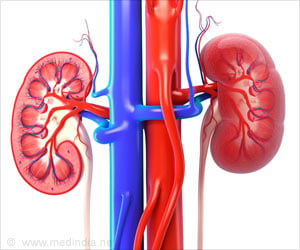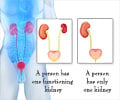A simple yet innovative blood test detects protein in the blood of pediatric diabetic patients at a risk of developing kidney disease.

- Researchers have developed a new test to predict the risk of kidney failure in pediatric diabetic patients.
- Pediatric diabetic patients have a high risk for diabetic nephropathy.
- The innovative test will ensure better care for the pediatric patients.
- 50% of children with diabetes develop diabetic nephropathy during adolescence
- >75% of children develop diabetic nephropathy during early adulthood.
TOP INSIGHT
Blood test to predict risk of kidney disease in pediatric diabetic patients.
The risk factors for diabetic nephropathy include
- Duration of diabetes
- Puberty
- Diabetic control
- Genetic pre-disposition
- Hyperlipidemia (elevated lipids/lipoproteins level in the blood)
- Hypertension
Diabetic nephropathy testing method involves detection of increased urinary albumin. When there is a decline in kidney function, it leads to an increase in albumin in the urine, called microalbuminuria. Microalbuminuria is the first sign of kidney deterioration.
The level of microalbuminuria determines the extent of kidney damage. As the kidney decline progresses, the level of albumin increases and there is a shift from microalbuminuria to proteinuria, with increased albumin in the urine. It is important to test for the amount of albumin in the urine to monitor the stage of kidney damage, while taking the necessary treatment.
There are three different methods of urine collection to detect the presence of albumin in the urine.
b) Urine collected over a period of 4 hours or overnight
c) Spot urine
The level of albumin should be detected very often as the level of albumin can vary upto 40% the very next day.
Simple Blood Test to Detect Early Kidney Disease
Researcher Ioannis Papassotiriou and colleagues from Aghia Sophia Children’s Hospital in Athens have found that the detection of two proteins can be used as an early indicator of kidney disease.
a) Growth Differentiation Factor (GDF-15)
b) Chitinase-3-like Protein 1 (YKL-40)
The study included 56 type I diabetes pediatric patients between the ages 9 to 15 years with 49 healthy controls between the ages 6 to 19 years. The levels of GDF-15 and YKL-40 were determined at the start of the study and then again after a period of 12 to 15 months.
When the levels of these two proteins were determined, there were other parameters that were tested to determine kidney function.
a) Cystatin C which is used to ascertain the estimated glomerular filtration rate (eGFR)
b) Neutrophil Gelatinase Associated Lipocalin (NGAL)
The lead author Dr. Papassotiriou said “Defining new predictors as supplementary tests to urinary albumin excretion for the early diagnosis of diabetic nephropathy could accelerate effective management and treatment approaches needed to minimize the rates of severe renal morbidity and mortality in young patients with [type 1 diabetes].”
Levels After 12-15 Months
- GDF 15 levels found to be higher in diabetic patients (366.7 pg/mL) than in controls (278.6 pg/mL)
- YKL-40 showed no increase initially.
- As the study progressed, YKL-40 levels increased from 17.4 ng/mL to 20.5 ng/mL for diabetic patients.
- Increase in GDF-15 correlated with decrease in eGFR values
- Increase in YKL-40 correlated with increase in GDF-15 and NGAL
- An increase in both the studied proteins correlated with a decrease in kidney function “This is the first study to demonstrate a predictive role for serum GDF-15 and YKL-40 as early markers of diabetic nephropathy in children and adolescents with [type 1 diabetes] before severe overt nephropathy occurs,” said Papassotiriou.
The study provides promise for a simple blood test that can be used to predict the risk of kidney damage at an early stage.
Source-Medindia
 MEDINDIA
MEDINDIA



 Email
Email










